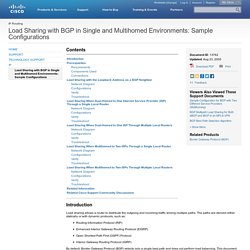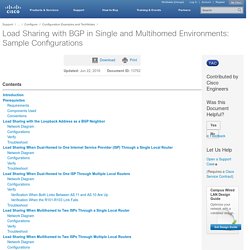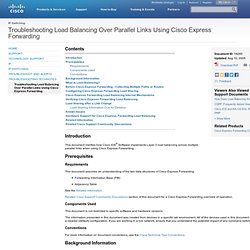

Load Sharing with BGP in Single and Multihomed Environments: Sample Configurations [IP Routing. Introduction Load sharing allows a router to distribute the outgoing and incoming traffic among multiple paths.

The paths are derived either statically or with dynamic protocols, such as: Routing Information Protocol (RIP) Enhanced Interior Gateway Routing Protocol (EIGRP) Open Shortest Path First (OSPF) Protocol Interior Gateway Routing Protocol (IGRP) By default, Border Gateway Protocol (BGP) selects only a single best path and does not perform load balancing.
This document shows how to perform load sharing in different scenarios with the use of BGP. Prerequisites Requirements Ensure that you meet these requirements before you attempt this configuration: Components Used This document is not restricted to specific software and hardware versions. The information in this document was created from the devices in a specific lab environment. Conventions Refer to Cisco Technical Tips Conventions for more information on document conventions. Load Sharing with the Loopback Address as a BGP Neighbor. Load Sharing with BGP in Single and Multihomed Environments: Sample Configurations [IP Routing. Introduction Load sharing allows a router to distribute the outgoing and incoming traffic among multiple paths.

The paths are derived either statically or with dynamic protocols, such as: Routing Information Protocol (RIP)Enhanced Interior Gateway Routing Protocol (EIGRP)Open Shortest Path First (OSPF) ProtocolInterior Gateway Routing Protocol (IGRP) By default, Border Gateway Protocol (BGP) selects only a single best path and does not perform load balancing. This document shows how to perform load sharing in different scenarios with the use of BGP.
Prerequisites Requirements Ensure that you meet these requirements before you attempt this configuration: Components Used This document is not restricted to specific software and hardware versions. The information in this document was created from the devices in a specific lab environment. Conventions Refer to Cisco Technical Tips Conventions for more information on document conventions. Load Sharing with the Loopback Address as a BGP Neighbor Verify. Per Packet Load Balancing. Troubleshooting Load Balancing Over Parallel Links Using Cisco Express Forwarding [IP Switching. Related Cisco Support Community Discussions section of this document for a Cisco Express Forwarding overview of operation.

Components Used This document is not restricted to specific software and hardware versions. The information presented in this document was created from devices in a specific lab environment. All of the devices used in this document started with a cleared (default) configuration. If you are working in a live network, ensure that you understand the potential impact of any command before using it. Conventions For more information on document conventions, see the Cisco Technical Tips Conventions. Background Information IP switching is the internal mechanism used by Cisco IOS to forward packets through a router. IP switching mechanisms support two general modes, per-packet and per-destination. What Is Load Balancing? Load balancing describes the ability of a router to transmit packets to a destination IP address (also known as an IP prefix) over more than one path.
How Does Load Balancing Work? Introduction Load balancing is a standard functionality of the Cisco IOS® router software, and is available across all router platforms.

It is inherent to the forwarding process in the router and is automatically activated if the routing table has multiple paths to a destination. It is based on standard routing protocols, such as Routing Information Protocol (RIP), RIPv2, Enhanced Interior Gateway Routing Protocol (EIGRP), Open Shortest Path First (OSPF), and Interior Gateway Routing Protocol (IGRP), or derived from statically configured routes and packet forwarding mechanisms. It allows a router to use multiple paths to a destination when forwarding packets. Prerequisites Requirements There are no specific requirements for this document. Components Used This document is not restricted to specific software and hardware versions.
Conventions For more information on document conventions, refer to Cisco Technical Tips Conventions. Load-Balancing Per-Destination and Per-Packet Load Balancing.